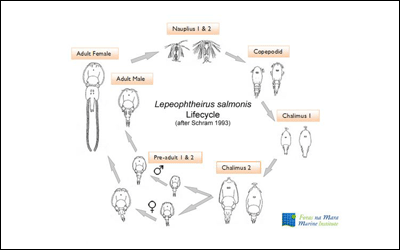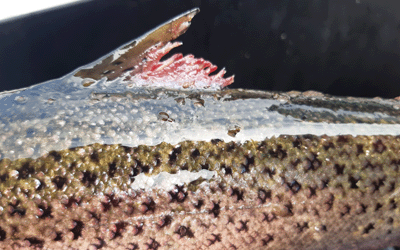Our wild salmon and sea trout are a vital part of Scotland’s heritage and they are now under threat. Their journey to sea carries many dangers, including the risk of fatal damage from sea lice – a natural marine parasite which is amplified by the presence of salmon farms.
Sea lice are naturally-occuring parasites. Two species of sea lice in Scottish waters, Lepeoptheirus salmonis and Caligus elongatus, are the primary marine ectoparasites of wild and farmed salmonids in the North Atlantic. Sea lice infestation of the host fish is characterised by skin damage, stress and osmoregulatory imbalance, which are most apparent once the parasites moult to the mobile preadult and adult stages.

The life cycle of Lepeoptheirus salmonis is shown in Figure 1 – further information is available on the Marine Institute website.
Approximately 500,000 wild Atlantic salmon return to Scotland’s rivers every year. As there is no physical or biological separation of these fish from the natural environment, the number of potential hosts for sea lice is now orders of magnitude greater than would be the case without commercial fish farming. This means that finfish farms are a much more important contributor than wild fish to the total numbers of sea lice in the Scottish coastal zone.
 The total number of lice on finfish farms is influenced by both the number of lice per farmed fish and the total number of farmed salmon. Whilst generally the number of lice per farmed fish has declined in recent years, Scottish farmed salmon production has increased over the same period.
The total number of lice on finfish farms is influenced by both the number of lice per farmed fish and the total number of farmed salmon. Whilst generally the number of lice per farmed fish has declined in recent years, Scottish farmed salmon production has increased over the same period.

Sea lice infestation of wild fish remains a concern in Scotland. Monitoring of sea lice on wild sea trout in the ‘aquaculture zone’ has demonstrated that, in some years, a high proportion of sea trout have sea lice burdens which can result in stress or even mortality. In addition, multiple studies conducted in Ireland and Norway have found that treatment with anti-sea lice agents (to protect the emerging smolts from sea lice acquired in the coastal zone) increases the likelihood of fish surviving to return as adults. The studies estimate that sea lice infestation can result in mortality for between 0-39% of the untreated fish. Similar to sea trout in Scotland, the Irish and Norwegian studies have shown a great deal of year-to-year and site-to-site variation in the magnitude of sea lice impacts.
The Marine Directorate have produced a summary of information relating to impacts of salmon lice from fish farms on wild Scottish sea trout and salmon.
Following extensive consultation, SEPA have announced a new risk assessment regulatory framework to manage sea lice interactions between fish farms and wild fish, which considers the total number of lice affecting wild salmon populations within defined ‘Wild Salmon Protection Zones’. Fisheries Management Scotland will continue to work closely with SEPA to ensure that this framework is robust, transparent, enforceable and enforced (as recommended by the Salmon Interactions Working Group) as it is implemented across Scotland.
